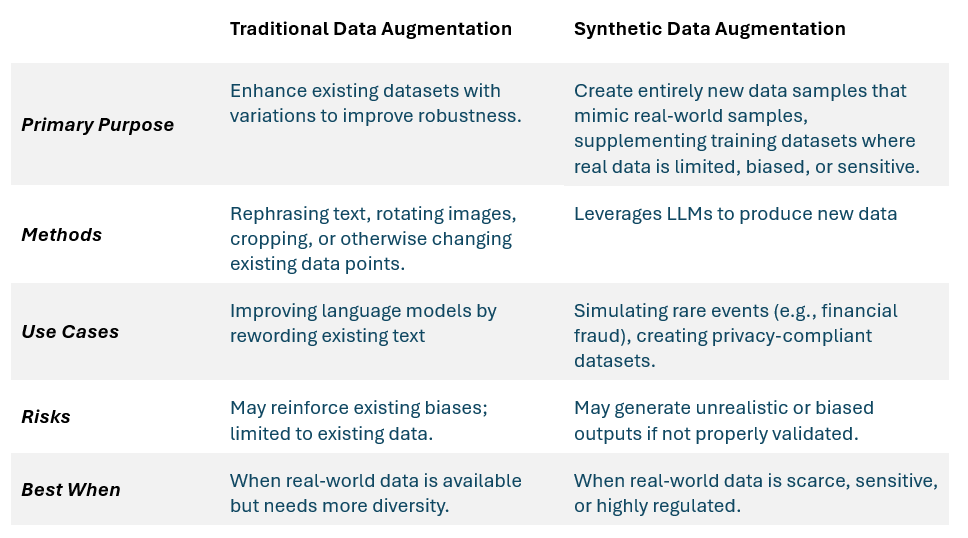Most modern, business-focused software systems rely on high-quality data to function effectively. As artificial intelligence continues to shape these systems that support knowledge work, the demand for high-quality, diverse, and reliable data has never been greater.
The problem is that real-world data is often scarce, incomplete, or unintentionally biased, which can limit its effectiveness. Research shows that in regulated environments like financial services and healthcare, organizations may have access to only 40–50% of the data necessary for comprehensive analytics due to strict privacy and compliance requirements
Data augmentation enhances existing datasets by generating variations which can improve system robustness. But with generative AI advancements, synthetic data now plays a more significant role – not just in creating test data, but in expanding and refining the datasets AI systems rely on. Unlike traditional augmentation techniques that change existing data with defined rules in place (word banks, etc.), synthetic data is created from scratch, offering an innovative way to supplement real-world information.
This post explores how synthetic data generation is shaping AI-driven knowledge work through the business systems they interact with every day. We’ll dig into the concept of synthetic data and its role in data augmentation, examine the ways large language models (LLMs) contribute to creating high-quality synthetic datasets, and discuss strategies for leveraging synthetic data. Finally, we’ll look at the impact on knowledge workers and the challenges organizations must navigate when integrating synthetic data into their systems.
What is Data Augmentation with Synthetic Data?
Data augmentation is a technique used to enhance test and training datasets by generating new variations of existing data, helping models generalize better and perform more reliably in real-world applications. However, these approaches have traditionally relied on changing existing data rather than generating entirely new examples.
Synthetic data takes this concept further by creating entirely new data points that are not necessarily derived from real-world observations. Rather than simply reshuffling or changing what already exists, synthetic data generation produces original, realistic data samples. In the context of text-based AI systems, this means generating artificial documents, simulated customer interactions, or fictionalized reports that mimic real-world data.
EXAMPLE: Real-world legal documents can be difficult to obtain due to confidentiality concerns, and publicly available contracts may not fully represent the variety of agreements used in practice. Synthetic data can be used to generate entirely new contracts that mimic real-world patterns without exposing sensitive information. A system with access to general contract language could generate a completely new – but legally plausible – vendor agreement:
“In the event of a service disruption, the provider shall offer a pro-rata credit for the affected period, provided that the customer notifies the provider in writing within 10 business days.”
While no such agreement exists in a real-world dataset, the synthetic contract keeps realistic legal structure, terminology, and logic, allowing AI systems to learn how different clauses are typically phrased.
The use of synthetic data addresses persistent challenges in system development (and specifically, AI model development):
- Data scarcity is a major issue, particularly in specialized fields where real-world data is difficult to obtain, such as legal, medical, or financial applications. Synthetic data helps bridge these gaps by generating contextually relevant examples.
- Bias reduction is another key area – since AI models often reflect the biases of their training data, synthetic data can be used to create more balanced datasets by introducing underrepresented perspectives.
- Privacy concerns limit the use of sensitive data in AI training. Synthetic data can be generated to mirror real-world patterns without exposing personal or confidential information, making it a valuable tool for compliance-conscious industries.

The Role of LLMs in Synthetic Data Generation
Traditional rule-based methods create artificial data using predefined patterns, but they lack flexibility. LLMs, on the other hand, can generate content that is contextually relevant and semantically rich, making them ideal for augmenting AI-driven systems.

Now that we’ve explored how LLMs contribute to synthetic data, let’s examine specific strategies organizations can use to implement it effectively.
Strategies for Synthetic Data Generation

Text-Based Augmentation
One of the most straightforward ways to use synthetic data produced by an LLM is through simple text-based augmentation – rephrasing, expanding, or summarizing existing content to create more diverse variations. You may think this strategy falls more in line with our definition of traditional Data Augmentation from above. The distinction is that with this approach – we use the LLM to help identify and augment existing content to ensure the full intent of existing data is captured. Instead of predefining rules or transformations such as synonym substitution or word shuffling that an augmentation script must follow, we rely on the LLM to reason over the existing data and infer where improvements should be made, using basic instructions.
EXAMPLE: Internal Knowledge Base Refinement
Consider an AI-powered internal knowledge base used by employees to find company policies. If the original question is: “What is the remote work policy for full-time employees?” An LLM can generate alternative phrasings such as:
– How does the company handle remote work for full-time staff?
– Are full-time employees allowed to work remotely?
– Can I work from home if I’m a full-time employee?
By training the system or making these variations available through retrieval augmented generation (RAG), the system improves its ability to surface relevant information, regardless of how the user phrases their query. This same principle applies across various domains, from customer support chatbots that need to recognize diverse user intents to compliance monitoring systems that must detect policy violations described in diverse ways.
Domain-Specific Synthesis
While general-purpose synthetic data can improve performance, many use cases require domain-specific data that aligns with industry standards, terminology, and regulatory constraints. Domain-specific data synthesis involves using LLMs to generate artificial datasets tailored to a particular field, to help ensure relevant information exists in a knowledgebase or training set. This is especially valuable in industries where real-world data is scarce, sensitive, or subject to strict compliance requirements.
In healthcare, for example, AI models designed for clinical decision support or medical research require high-quality patient data. However, due to patient privacy laws such as HIPAA, access to medical records is obviously restricted. Instead of relying solely on de-identified datasets, organizations can use LLMs to generate fictional but medically plausible case studies that reflect diverse symptoms, conditions, and treatment responses.
EXAMPLE: Domain-Specific Data Synthesis in Healthcare
Let’s assume a healthcare organization is developing a system to assist physicians in diagnosing rare diseases. Instead of relying on a handful of real-world cases for Gaucher’s disease, an inherited metabolic disorder, the LLM generates and stores new cases that mimic the characteristics of real patients while ensuring diversity in presentation. A synthetic case might include:
Patient Profile: 42-year-old female presenting with chronic fatigue, easy bruising, and mild hepatosplenomegaly. Genetic testing confirms a mutation in the GBA gene, with an enzyme assay revealing reduced glucocerebrosidase activity. The patient has a history of bone pain episodes and mild anemia.
By generating multiple variations of these cases, the system has the potential to recognize different symptom patterns, disease progressions, and patient demographics, improving its ability to aid with early diagnosis. And since the data is entirely synthetic, it avoids privacy concerns while ensuring the system is exposed to a broader range of realistic medical scenarios.
Whether through generating medical case studies, financial transaction records, or industry-specific reports, domain-specific data synthesis offers a practical way to provide high-quality, representative datasets without the constraints of real-world data limitations.
Scenario Simulation
Another effective use of synthetic data is scenario simulation, where LLMs create realistic, hypothetical situations that systems can use for training and decision-making. Unlike text-based augmentation or domain-specific synthesis, scenario simulation focuses on modeling real-world interactions, events, or decision-making processes to improve system robustness in handling complex and dynamic environments. This approach is particularly valuable in fields where real-world data is difficult to collect or when expecting rare but critical events is essential.
Example: Emergency Response Scenario Simulation
A city’s emergency management agency is developing an AI system to aid first responders during large-scale disasters. The system must be able to interpret incoming reports, assess risks, and suggest response strategies in real time. Since actual disaster data is highly unpredictable and often incomplete, the agency uses an LLM to generate synthetic crisis scenarios for training purposes. For instance, an LLM might generate a simulated earthquake scenario:
Scenario: A 7.1 magnitude earthquake has struck a metropolitan area at 3:42 PM, causing major infrastructure damage and power outages. The system receives multiple reports:
– Fire Department: Structural collapses were reported at three locations; search and rescue operations are underway.
– Medical Services: Hospitals at 85% capacity, with an influx of trauma patients.
– Transportation: Two main highways are blocked due to debris, delaying emergency vehicle response times.
The system could be trained on hundreds of these hypothetical scenarios, allowing it to refine its ability to classify urgent vs. non-urgent incidents, recommend optimized routes for ambulances, and aid in prioritizing emergency response actions. These synthetic simulations help ensure that the system is exposed to a wide variety of disaster conditions, helping responders adapt to unpredictable situations they may not have met.
Feedback-Driven Augmentation
Synthetic data generation is often most effective when it evolves in response to real-world usage. Feedback-driven augmentation uses user interactions, domain expert input, and system performance metrics to refine and improve synthetic data generation iteratively. Rather than relying solely on static datasets, this approach ensures that synthetic data stays relevant, representative, and aligned with the needs of the system and its users. By continuously incorporating feedback, organizations can enhance their AI-driven systems, whether they are trained models or retrieval-based applications (RAG).
One of the key benefits of feedback-driven augmentation is that it encourages domain-specific fine-tuning of synthetic data. For example, a system deployed in a customer support environment may generate synthetic customer inquiries to improve its ability to retrieve relevant responses from a knowledge base. However, as users interact with the system, patterns in misunderstood queries, inaccurate responses, or often-asked variations appear. Instead of relying on static synthetic data, feedback mechanisms allow these gaps to be found and addressed in an iterative cycle.
Example: Feedback-Driven Augmentation in Customer Support
A company deploys an AI-powered virtual assistant that helps employees navigate internal HR policies. The system uses RAG to retrieve policy documents and generate responses, but early interactions reveal that certain employee questions aren’t retrieving the most relevant information. To improve response accuracy, the system integrates feedback loops:
– User Feedback Collection: Employees rate responses, flag incorrect answers, and suggest missing policy topics.
– Performance Monitoring: The system tracks instances where users rephrase questions or abandon interactions due to incomplete answers.
– Synthetic Data Refinement: Based on flagged queries, an LLM generates new synthetic variations of common employee questions, ensuring the retrieval process better aligns with real-world phrasing.
– Continuous Iteration: Over time, the system dynamically expands its retrieval capabilities, refining its ability to find relevant sections of policies based on evolving user needs.
By incorporating real-world feedback loops, feedback-driven augmentation helps organizations bridge the gap between synthetic and real-world data, making AI-driven systems more adaptive, exact, and aligned with user expectations.
Impacts on Knowledge Workers
While synthetic data enhances AI capabilities, its real value appears in how it supports knowledge workers – empowering them to focus on strategic tasks, improving trust in AI outputs, and fostering a more collaborative relationship between human ability and intelligent systems.
Enhanced Productivity
One of the most immediate benefits of synthetic data is its ability to free knowledge workers from repetitive data generation and augmentation tasks. As we said before, modern software systems rely on high-quality, well-structured datasets to provide a valuable user experience. Instead of manually curating datasets or refining AI responses, knowledge workers can redirect their efforts toward high-value activities, such as refining business strategies, conducting deeper analysis, or focusing on creative problem-solving.
For example, in regulatory compliance, professionals often spend hours reviewing policy documents to ensure adherence to new laws. With synthetic data, AI-driven systems can generate realistic compliance scenarios, allowing experts to assess responses, detect inconsistencies, and adapt policies faster – without manually crafting every example themselves.
Reduced Barriers to Entry
Superior quality data can be difficult or expensive to obtain – especially at scale. Synthetic data generation can lower this barrier by creating datasets that mirror real-world scenarios, allowing organizations to develop AI-driven systems without requiring extensive proprietary data. This is particularly valuable in specialized fields where data is either scarce or restricted due to privacy concerns.
For instance, a startup developing an AI-powered financial advisory tool may lack access to proprietary banking data. By generating synthetic financial transactions, investment profiles, and market trends, the system can still be assessed, refined, and confirmed before deployment – making it available to function effectively even before securing real-world data partnerships.
Increased Confidence in AI
One of the persistent concerns in AI adoption is trust in system-generated outputs. When knowledge workers rely on AI for decision-making, they need assurance that the system is drawing from a high-quality, representative dataset. Synthetic data plays a key role in improving AI robustness, ensuring that systems perform well across a wide range of scenarios, including edge cases that may be underrepresented in real-world datasets.
Collaboration with AI Systems
Synthetic data generation is not typically a fully automated process – knowledge workers play a critical role in guiding, confirming, and refining how synthetic data is created and used. AI-driven systems require human oversight to ensure that generated data aligns with industry standards, supports ethical integrity, and stays free of unintended biases.
For instance, in medical AI applications, clinicians may work alongside AI-driven systems that generate synthetic patient case studies for rare diseases. While the system can create diverse cases, medical professionals must confirm that the generated data stays clinically plausible and aligns with established diagnostic patterns. This collaboration ensures that AI-driven systems provide value without introducing misleading or irrelevant information.
Challenges and Considerations
While synthetic data offers clear advantages in improving AI-driven systems, its use comes with important challenges. Organizations must carefully manage how synthetic data is generated, confirmed, and integrated to ensure that AI systems stay dependable, fair, and effective. Without proper oversight, synthetic data can introduce unintended risks, including loss of diversity, ethical concerns related to bias, and an over-reliance on artificially generated information. Addressing these considerations is key to balancing synthetic data with real-world data and ensuring that AI-driven systems perform optimally across diverse applications.
Over-Reliance on Synthetic Data
One of the primary risks of synthetic data is over-reliance, particularly when artificially generated datasets become the dominant or exclusive source of information for AI-driven systems. While synthetic data can enhance coverage and fill in gaps where real-world data is scarce, it may not fully capture the complexity or unpredictability of real-world scenarios.
For example, in fraud detection, an AI system trained primarily on synthetic fraudulent transactions may struggle when confronted with new, evolving fraud tactics that weren’t reflected in the generated dataset. Fraudsters continually adapt their methods, and if the system has been exposed only to synthetic patterns, it may miss novel fraud behaviors that don’t fit within its predefined assumptions.
To mitigate this risk, organizations should blend synthetic data with real-world examples (when available) to ensure AI-driven systems stay grounded in actual behaviors and evolving trends. This balance allows synthetic data to extend system capabilities without leading to overfitting on artificial patterns that don’t fully represent reality.
Ethical Concerns and Bias Reinforcement
Synthetic data does not inherently remove bias – it can, in some cases, amplify biases present in the original data if not carefully curated. If an AI-driven system is trained on synthetic data that mirrors historical biases, it may perpetuate the same issues rather than mitigate them.
To address these ethical concerns, organizations should implement bias detection and correction mechanisms when generating synthetic data. This includes:
- Diverse Data Generation: Ensuring that synthetic datasets incorporate a broad range of perspectives rather than simply replicating dominant trends in historical data.
- Human Oversight: Knowledge workers play a key role in reviewing synthetic datasets for unintended biases and adjusting to align with ethical standards.
- Transparency and Explainability: Clearly documenting how synthetic data is generated and providing visibility into the decision-making process of AI-driven systems.
Balancing Synthetic and Real-World Data
While synthetic data can enhance AI system capabilities, it should not always replace real-world data entirely. The most effective AI-driven systems strike a balance – they use synthetic data for scalability while anchoring their outputs in real-world observations. This is particularly important for RAG-based systems, where retrieval from actual knowledge sources ensures that AI-generated responses stay factually grounded.
Organizations can improve performance by adopting a hybrid approach, where synthetic data:
- Expands the training dataset when real-world data is limited or unavailable.
- Fills in knowledge gaps for edge cases or low-frequency events.
- Supports stress testing by exposing systems to a wider variety of conditions.
- Enhances retrieval-based AI systems by generating alternative phrasing or structured context to improve query matching.
By thoughtfully integrating synthetic data while ensuring strong validation and real-world anchoring, organizations can develop AI-driven systems that are more adaptable, fair, and effective in supporting knowledge work.
Conclusion
Synthetic data is becoming an essential tool for improving the quality, robustness, and adaptability of the systems knowledge workers use daily. This is particularly true of AI-based software systems. By addressing challenges such as data scarcity, privacy concerns, and bias, synthetic data can allow organizations to expand the effectiveness of their systems while maintaining security, compliance, and ethical standards. Synthetic data extends the capabilities of AI in ways that would be difficult or impossible using real-world data alone.
At the center of this evolution are large language models (LLMs), which offer the ability to generate contextually rich, semantically correct, and domain-specific synthetic data. From rephrasing and augmenting text to generating complex multi-modal datasets, LLMs enable software systems to work with a broader and more representative set of information. When combined with retrieval-based approaches like Retrieval-Augmented Generation (RAG), synthetic data ensures that AI-driven systems retrieve, generate, and reason over knowledge with greater accuracy and relevance.
For knowledge workers, synthetic data does not replace expertise – it enhances it. By automating data generation, refining retrieval accuracy, and expanding AI’s ability to model real-world scenarios, synthetic data frees knowledge workers to focus on high-value tasks, such as decision-making, strategic analysis, and innovation. As AI adoption accelerates, organizations that thoughtfully integrate synthetic data into their knowledge management, decision support, and automation strategies will be better positioned to unlock more accurate, efficient, and scalable AI-driven insights.
Now is the time for organizations to explore and experiment with synthetic data strategies. Synthetic data provides a flexible and scalable approach to improving AI systems. And by balancing synthetic and real-world data and ensuring strong validation processes, organizations can build AI solutions that are not only more powerful but also more dependable and aligned with real-world needs.
Take Action Now
For AI Practitioners and Data Teams: Assess your organization’s current AI workflows to find opportunities for synthetic data to improve performance, reduce bias, or enhance data diversity. Experiment with LLM-generated synthetic data to expand training datasets or improve retrieval-based AI applications. As an example, check out this notebook that walks through an example of Synthetic Data Generation in Azure AI Foundry, or take a look at Gretel on Google Cloud.
For Business and Knowledge Leaders: Take the first step by finding workflows in your organization that could benefit from synthetic data.
References & Further Reading
- Zaitian Wang, Pengfei Wang, Kunpeng Liu, Pengyang Wang, Yanjie Fu, Chang-Tien Lu, Charu C. Aggarwal, Jian Pei, and Yuanchun Zhou. 2024. A Comprehensive Survey on Data Augmentation. https://arxiv.org/abs/2405.09591
- Haponik. 2024. Generative AI for Data Augmentation: How to Use It – Addepto, https://addepto.com/blog/generative-ai-for-data-augmentation-how-to-use-it/.
- All Awan. 2024. A Complete Guide to Data Augmentation – datacamp, https://www.datacamp.com/tutorial/complete-guide-data-augmentation
- KRAUSE. 2025. Nvidia, Google, OpenAI Turn To ‘Synthetic Data’ Factories To Train AI Models – investors.com, https://www.investors.com/news/technology/nvidia-stock-tech-giants-use-synthetic-data-train-ai-models/
- OpenAI. (2025). ChatGPT [Large language model]. https://chat.openai.com/chat
- Microsoft. (2025). Copilot [Large language model]. https://copilot.microsoft.com/






